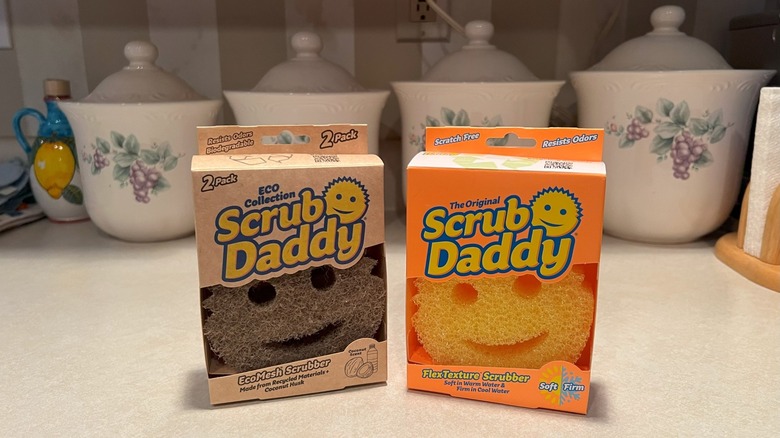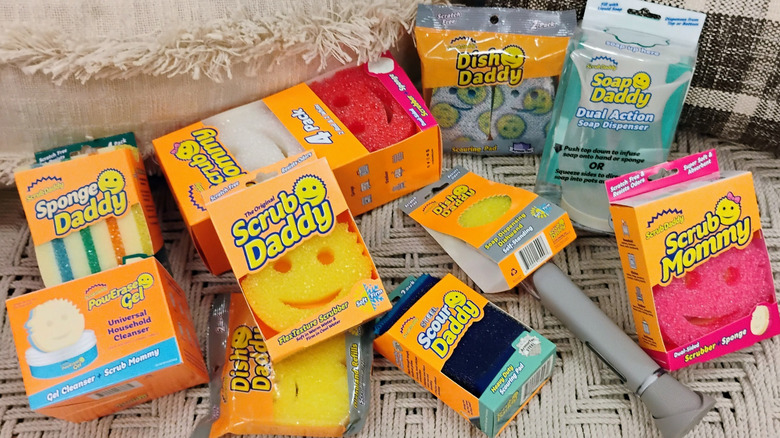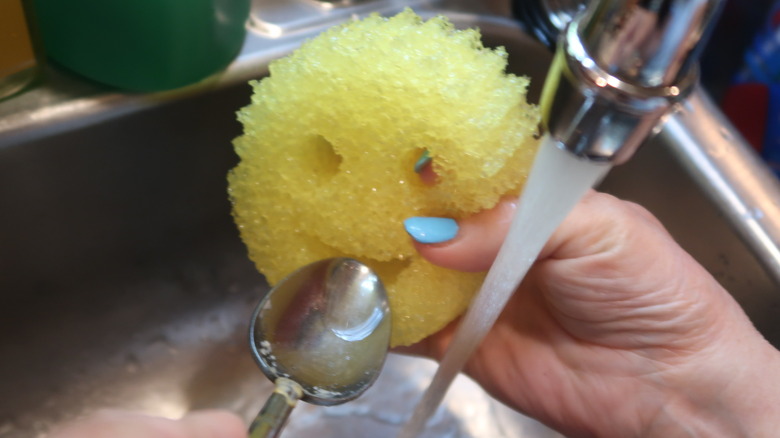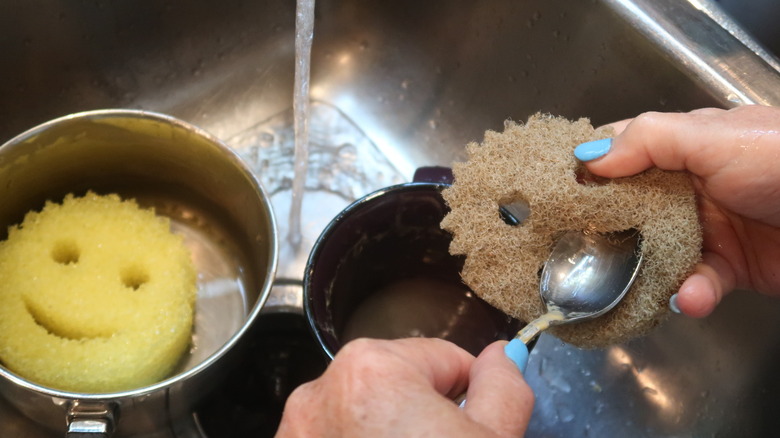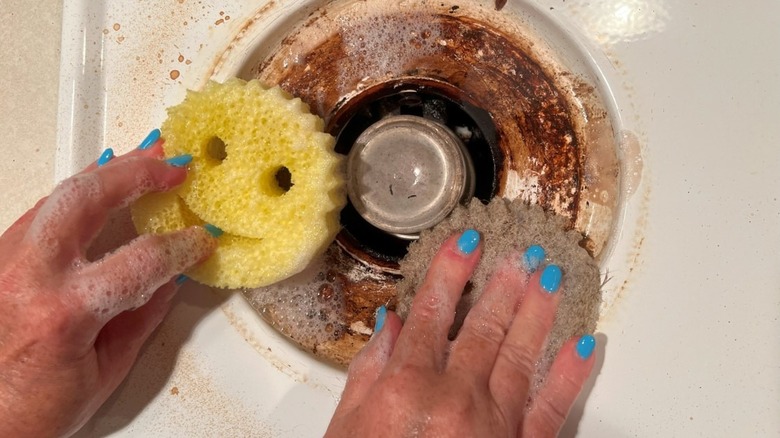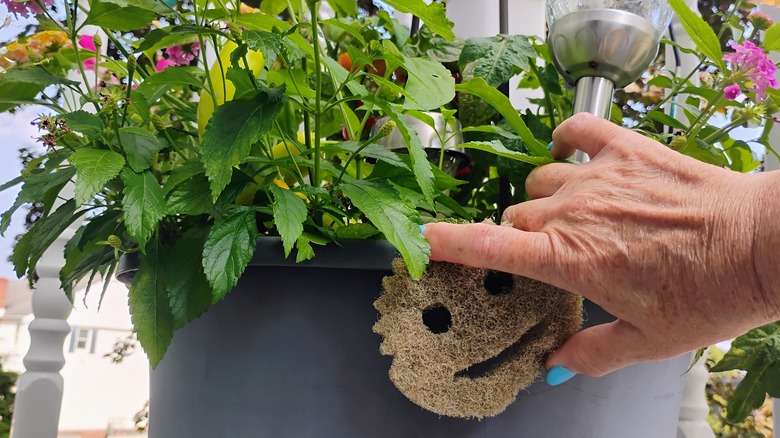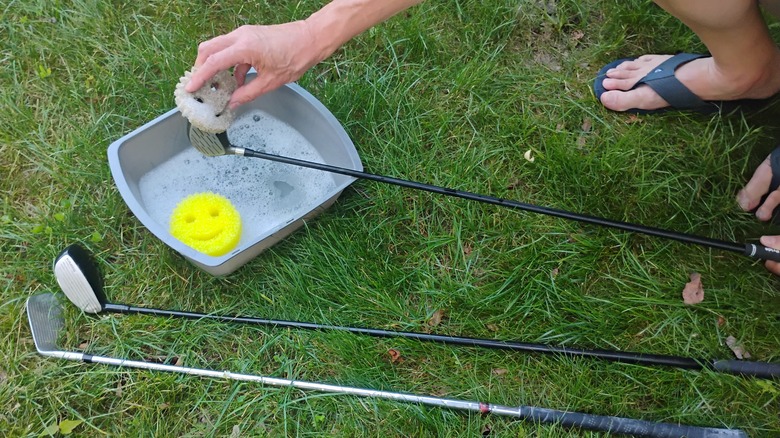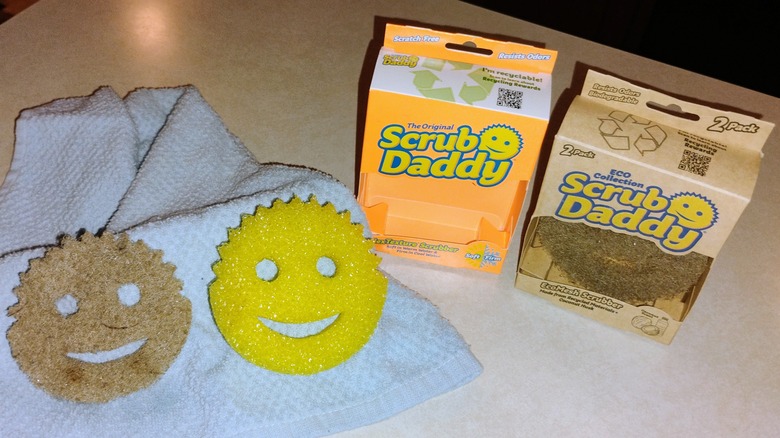Original Scrub Daddy Or EcoMesh? We Cleaned With Both And Here's How They Did
Over the years, I've tried enough kitchen cleaning products and gadgets to fill every drawer and cabinet a couple times over. By the time a new product attracted attention on "Shark Tank" in 2012, I had been burned by empty or half-hearted promises of easy cleanups too many times to care about the television show's newest venture. I couldn't hear the siren song of the Scrub Daddy despite its almost-irresistible smiling face. But I finally decided to give the unusual scrubbing pad a try. It just so happens, it really was more than a pretty face! As promised by its manufacturer, the product is soft and pliable when rinsed in warm water, but it stays firm when doused in cold water. It's a versatile scrubber, but that didn't stop the company from expanding over the years to other helpful products, including their eco-friendly version that comes in a two-pack for just slightly more money than the traditional Scrub Daddy.
I put both versions to the test. Was the original Scrub Daddy really as strong as I thought it was? Did they both handle the grit and grime equally well, or did I need to make some sacrifices for the good of the environment? Was the new one worthy of the extra money it cost? With experts, including from Harvard, weighing in about things like microplastics and their impact on our planet, would this new product billed as more environmentally-sound add to the problems or ameliorate them? Let's find out!
Scrub Daddy, Mommy, and a whole scrub extended family
The Scrub Daddy company took off after its 2012 appearance on television, and with the rise in sales came a growth in products. I kept my focus for this experiment on exploring the properties and value of the original Scrub Daddy, which retails on the company's website for $3.99, and a newer product, the Scrub Daddy EcoMesh, which I saw online and in stores in a 2-pack box for $4.69. Take note that the EcoMesh scrubbers are thinner by half than the original pads.
Despite my intention on staying focused on the two products, browsing in physical stores and online and immersing myself in all things Scrub Daddy made me want to join those who sing its praises. There are so many scrubbers in a plethora of colors and configurations (including holiday and seasonal styles). I also was tempted to load my online cart with dish scrubbers and mops and more. I resisted for now because all the research was telling me that these little scrubbers were tough, and it would take a lot of messes to wear them down. I wanted to test their longevity in addition to their economy and practicality, so the other products would have to wait their turn. I turned my attention to seeking out some of our household's cleaning needs both indoor (especially in the kitchen) and outdoor. But first I couldn't help but wonder what exactly those two Scrub Daddy sponges were made of.
What is this smiling scrubber, Daddy-O?
I'm one of "those" people: I talk to anyone and smile at babies in the pew in front of me in church. It's no wonder I smile back at inanimate objects like the Scrub Daddy products. The original yellow polymer foam-based cleaning tool is reminiscent of the iconic happy face that was created in 1963 and exploded in popularity in the 1970s. Happy faces on your school notebooks, however, don't scrub your microwave, bathtub, and muddy boots. By the way, the scrubbers come in different colors now instead of the original yellow so that you can use a different shade for each of those purposes — so don't worry about clearing the waxy coating off your apples with the same Scrub Daddy that you use to wipe down the dog's poop shovel!
This cheerful smiling face makes me grin because it's also a hard worker with a dual personality, and I giggled a little when I first discovered the Scrub Daddy's presto change-o trick of changing texture with the temperature of the water. I don't generally keep a bowl of ice water around when using my Scrub Daddy sponge, but it's an option if you need to quickly go from wearing down stuck-on gunk to ordinary washing. Perhaps you always line your baking sheets with foil or parchment, but someone else in your household might not. It's easier to grab the Scrub Daddy than to growl at the person who helped out with the cooking.
Scrubbing pots, pans, and other greasy kitchen things
Both the original Scrub Daddy and the EcoMesh were flawless in getting dishes clean, even whisking away gooey mac and cheese as though it were nothing more than buttered pasta. If you aren't like me and are new to the products, you still might not have known your Scrub Daddy was made to do some of the things it can do, like wash your spoons as though it's licking them clean. My fingers fit perfectly in the eye holes (though I felt like I should apologize to the sponge), which made it good for gripping as I found myself sliding anything narrow enough through the mouth, like the sticky splatter screen handle from frying bacon.
I was scowling, however, after breaking a glass while washing it with the original smiling scrubber. Maybe the water wasn't warm enough to keep the Scrub Daddy as flexible as needed, or I overestimated the size of the opening, but a dish cloth wouldn't have resulted in broken glass.
As I cleaned my way through the kitchen, I found that both products were good for scrubbing ordinary things like the sink, countertops, and appliances. Neither had much effect on the baked-on stickiness on the inside window of the bread machine, unfortunately, even though I tried scrubbing in a circular motion as experts often recommend. My wood cabinets looked outstanding after a light rubbing with just water, though the slightly gentler EcoMesh seemed to have an edge.
Are we l'oven the Scrub Daddy products?
The biggest test for the original Scrub Daddy and the Scrub Daddy EcoMesh definitely was the boiled-over, cooked-on grime that had accumulated under the stove's drip pan. I gave the scrubbers an equal test, using nothing but water, ordinary dish soap, and lots of elbow grease (the old-fashioned term for using your muscles to rub really hard). I didn't use any other cleaning products, such as TikTok's favorite cleaner that promises to leave dirty oven doors sparkling clean, even though the recommended pink paste is safe to use on lots of household surfaces, stovetops included. Great as the scrubbers are — with or without elbow grease — they failed on the dirty burner bowls. After 10 minutes of intense scrubbing, I gave up. Neither Scrub Daddy was up to that particular challenge without including a special cleaning agent. I should have heeded the advice of the University of Florida Institute of Food and Agricultural Sciences Cooperative Extension Service and prevented the mess in the first place.
I didn't have any better luck with my oven. Without using an oven cleaner, the Scrub Daddy sponges weren't up to the task. When I realized I was going to be disappointed by the result, I concentrated on the oven window, but just like with the window on the bread machine, the baked-on oily grime wasn't budging no matter how much persuasion the smiling Scrub Daddys provided. It would seem that I found the supernatural Kryptonite to the super scrubbers, and it's baked-on grease.
Just how eco-friendly is that smiling brown Scrub Daddy?
The Scrub Daddy EcoMesh scrubber was easier on my wallet since there were two in the package. The thinner product kept up with the original — its thicker, firmer, more yellow cousin — but the EcoMesh seemed to require more effort to get items as clean as the original one. I tried to keep the playing field as level as possible by consistently testing the two products on the same items, under similar conditions, and approximately at the same time of day.
EcoMesh allows you to clean without introducing chemicals into the process, and anything that helps people use fewer chemicals in their cleaning is a good thing. It's not just good for the environment, but also for the health of individuals who might be dealing with problems such as asthma, according to a study published by CONSTANCES Cohort Study in 2022 in Indoor Air. But the original Scrub Daddy does the same thing, so it doesn't give the advantage to the EcoMesh.
I was impressed more by the Scrub Daddy company's efforts to be eco-friendly. Poly Free Planet discovered various ways in which Scrub Daddy mitigated any harm to environment, such as through their efforts at recycling, using environmentally sensitive manufacturing processes, and pursuing certifications for their work toward being more "green."
If both scrubbers work equally well and there are environmental and/or recycling options, is there a compelling argument to spend more money on EcoMesh? My answer is not necessarily; buy the one that speaks to you.
I didn't have to be clubbed over the head to be floored by Scrub Daddy's longevity
The Scrub Daddy manufacturer estimates that most users will need to replace their sponges every two weeks, though they mention on their FAQ page that the scrubbers' longevity varies widely from household to household. I use a variety of cloths, sponges, and other products, so perhaps that accounts for the fact that I had a difficult time wearing down my Scrub Daddy scrubbers, both the original one and the EcoMesh.
Try as I might, two months after starting my experiment, my Scrub Daddys still had a lot of life in them! They weren't worn out even though I did a lot of work around the house. I scrubbed the kitchen grout (there's a lot of it!), and when the inside was done, headed outside to scrub golf clubs. Most of the cleaning I did was either with plain water or mild soaps, as recommended by an Emory University professor and researcher whose work in chemistry and bacteria points toward avoiding the antibacterial additives that can lead to resistant strains. As a result, I scrubbed vigorously, and still the scrubbers didn't break down.
The original Scrub Daddy barely looked like it had been used at all. It remained bright yellow, intact, and when doused with hot water, it rinsed cleanly. The EcoMesh version showed a little more use. It seemed a bit grimier and exhibited some dirt smudges that didn't rinse out completely.
One Scrub Daddy product definitely made my cleaning bucket list
The more I used the original Scrub Daddy and the Scrub Daddy EcoMesh, the more I smiled at my good fortune. Overall, these products with the happy faces not only made me smile just by seeing their goofy designs, but also because I realized they made my cleaning tasks easier and quicker. I discovered pros and cons about each, but weighing everything, there was a clear winner. I knew I'd be seeing one particular Scrub Daddy smiling back at me from my bucket and dishpan. Keep smiling at me, Original Scrub Daddy!
While I appreciated the environmental sensitivity of the EcoMesh, that was offset by the ability to return used Scrub Daddys to the company for recycling, which isn't just great for planet earth, but is a money-saving trick all Scrub Daddy users should know. Ship used sponges back to the company through their rewards program (the shipping cost is paid by you), and the company gives you a credit toward purchases made through their website.
The EcoMesh was thinner, which made it easier to use on a few projects requiring tight access, but overall, it didn't clean as efficiently, and thorough cleaning was important since a clean house is healthy for bodies and minds. I did get two EcoMesh scrubbers for only slightly more money than one original Scrub Daddy, but there's little point if they don't do a great job.
